Abstract
This study investigates the spatial relationship between population distribution and tree cover loss in Nepal from 2000 to 2020, using satellite-based forest cover and population data along with statistical and geospatial analysis. Two statistical methods—linear regression (LR) and Geographically Weighted Regression (GWR)—were used to assess the influence of population on forest cover change. The correlation between total population and forest loss at the national level suggested little to no direct impact of population growth on forest loss. However, sub-national analysis revealed localized forest degradation, highlighting the importance of spatial and regional assessments to uncover land cover changes masked by national trends. While LR showed a weak national-level correlation, GWR revealed substantial spatial variation, with the coefficient of determination values increasing from 0.21 in 2000 to 0.59 in 2020. In some regions, local R2 exceeded 0.75 during 2015 and 2020, highlighting emerging hotspot clusters where population pressure is strongly linked to deforestation, especially along major infrastructure corridors. Using very high-resolution spatial data enabled pixel-level analysis, capturing fine-scale deforestation patterns, and confirming hotspot accuracy. Overall, the findings emphasize the value of spatially explicit models like GWR for understanding human–environment interactions guiding targeted land use planning to balance development with environmental sustainability in Nepal.
1. Introduction
Vegetation cover plays an important role in our environment. Several studies documented the role of vegetation in the removal of air pollution, urban cooling, climate change mitigation, stormwater management, biodiversity support, etc. [1,2,3,4]. Additionally, vegetation cover has been associated with economic benefits such as increased property values, economic resources, and a high return on investment in urban forestry [5]. However, by clearing vegetation, especially forests for agriculture or urbanization, humans are changing the Earth’s land cover in pervasive ways [6]. In particular, the Asian continent has seen explosive growth in population in recent decades. In the last 50 years, Asia’s population has grown by more than 2.5 billion people, from around 2.2 billion in 1970 [7]. As of 2023, Asia’s population was approximately 4.7 billion, accounting for nearly 60% of the world’s total population [8]. This dramatic population increase, combined with urban expansion, has significantly influenced the demand for resources and, consequently, environmental changes, including the loss of natural habitats in Asia. In particular, the expansion of infrastructure, agriculture, and industry has led to large-scale deforestation in Southeast Asia [9], exacerbating environmental challenges such as biodiversity loss, soil erosion, and climate change [10].
Specific to South Asian countries, the forest cover has experienced significant fluctuations over the past century. Historically, the region was covered by extensive forests, ranging from the dense tropical rainforests of the Western Ghats and Sri Lanka to the temperate forests of the Himalayas. However, deforestation has accelerated due to rapid agricultural expansion, logging, infrastructure development, and population growth. For example, in India, large-scale deforestation occurred during colonial rule, primarily for timber extraction, agriculture, and railway expansion [11]. Post-independence, agricultural expansion and urbanization further contributed to forest loss. However, in recent decades, afforestation initiatives such as the Joint Forest Management (JFM) program and the Green India Mission have attempted to reverse deforestation trends, leading to an increase in tree cover in some regions [12,13]. In the case of Afghanistan, the forest cover is relatively sparse, accounting for a small percentage of the country’s total land area. Most of its forests are concentrated in the eastern provinces, such as Nuristan, Kunar, and Paktia, where coniferous forests dominate the mountainous landscapes [14]. Over the past few decades, Afghanistan has experienced significant deforestation due to illegal logging, overgrazing, fuelwood collection, and land conversion for agriculture [15]. Ongoing conflict and political instability have further exacerbated forest degradation, limiting conservation efforts. In Bangladesh, the Sundarbans, the world’s largest mangrove forest, has faced deforestation due to shrimp farming, illegal logging, and rising sea levels caused by climate change [16]. The Chittagong Hill Tracts have also seen forest degradation due to shifting cultivation and encroachment [17]. In Pakistan, forest cover is among the lowest in the region, with deforestation driven by overgrazing, illegal logging, and infrastructure projects [18]. The country has launched afforestation initiatives such as the Billion Tree Tsunami project to restore degraded landscapes [19]. Sri Lanka, despite its rich biodiversity, has witnessed deforestation due to plantation agriculture (tea, rubber, and coconut), leading to habitat loss. Government-led conservation programs aim to protect remaining forests, especially in the central highlands [20].
In contrast to the above countries in South Asia, Nepal presents a unique case where community forestry programs have successfully contributed to forest regeneration [21]. Since the 1990s, local communities have been empowered to manage forests, leading to an increase in forest cover, particularly in the mid-hills [22]. Despite these successes, forest loss continues in specific pockets [23]. As of mid-2024, Nepal’s population was estimated at approximately 30 million, growing at about 1.0% per year, with a median age of 25 years, highlighting a youthful and expanding labor force [24]. Nepal’s economy reached USD 40.9 billion in Gross Domestic Product (current prices) with per capita income at USD 1378 (nominal) [25]. After a slowdown in 2023 to 2.0% real GDP growth, projections for FY2024/25 show a rebound to 5.1%, supported by rising remittances, over USD 11 billion, or 25–26% of GDP [26], and tourism recovery. Structurally, the economy remains dominated by the services sector (62%), followed by agriculture (25–30%) and industry. Nepal’s forest resources are among its most valuable natural assets, covering approximately 5.96 million hectares, or 40.36% of the total land area, according to the National Forest Inventory 2021 [27]. Forests are concentrated in the mid-hills (37%), High Mountains (32%), and Terai (31%), and support over 118 ecosystems and 7000+ plant species, including 180 species of mammals [28]. Nepal’s community forestry program, initiated in the late 1970s, is globally recognized; over 22,000 Community Forest User Groups (CFUGs) now manage nearly 2.9 million hectares, benefiting more than 3 million households [29]. Studies show forest cover increased by over 5% between the 1990s and 2020s, largely due to CFUG-led regeneration [30,31]. However, recent literature suggests that population pressures, especially in the Terai and mid-hills, continue to strain forest ecosystems. Over 60% of rural households still depend on fuelwood as their primary energy source [32], contributing to forest degradation. The deforestation is driven by agricultural expansion, infrastructure development, and illegal logging, exacerbated by population pressures and land encroachment [33]. Additionally, in some highland regions, overgrazing, fuelwood collection, and the expansion of road networks have contributed to localized forest degradation. Climate change-induced factors, such as forest fires and shifting monsoon patterns, further threaten Nepal’s forests [34,35]. Nepal has responded with policy reforms including the Forest Act [36], Forest Policy [37], and participation in REDD+ initiatives. The country received over USD 45 million from the World Bank under REDD+ for verified emission reductions between 2015 and 2020 [38]. These advances show promise, yet balancing conservation and development remains a challenge. Without integrating population dynamics into national land use and forest management plans, Nepal risks undermining decades of progress in community-led sustainable forestry.
This study focuses on Nepal with the main goal to quantify the relationship between population dynamics and forest loss over time (2000–2020). It specifically aims to determine whether the increasing population is one of the primary drivers of tree cover loss. It also seeks to understand how this relationship has changed over time. While population growth is often linked to deforestation, it is unclear how this relationship has evolved in Nepal over different periods (2000–2020). A literature review suggests that some regions, particularly the Terai plains, have experienced rapid population expansion [39]; however, it is not clear if such an increase also led to significant forest loss in neighboring districts due to population demand. This study seeks to analyze such a complex relationship by integrating remote sensing data with population data to identify spatial and temporal trends in forest cover change. The quantitative analysis focused on whether increased population in specific regions directly contributed to deforestation during different years. The study identifies hotspots where population–deforestation relationships are strong. Understanding these dynamics is crucial for developing sustainable forest management strategies that balance population growth with conservation efforts. The findings provide valuable insights for policymakers, conservationists, and land use planners aiming to ensure the long-term sustainability of Nepal’s forests.
2. Study Area
Nepal is situated between the longitudes 80.08 E and 88.17 E and latitudes 26.39 N and 30.42 N (Figure 1). The country is mountainous (3265 m above sea level) and bordered by Tibet and India. It has an area of 147,180 sq. km [40], of which nearly 41.6% of the land area is estimated to be forest area. The total population of Nepal is estimated to be 29,694,614 [40]. Figure 1 displays the land use land cover map of Nepal obtained from the Sentinel-2 2020 ESA World Cover Map, along with provincial boundaries. There are a total of 7 provinces and 77 districts in Nepal [41].
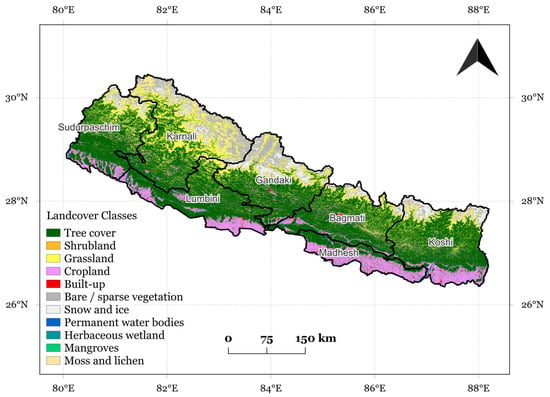
Figure 1.
Study area of Nepal with provincial boundaries overlaid on the 2020 land use land cover (LULC) map from the European Space Agency (ESA) WorldCover dataset.
3. Data and Sources
The datasets that were used for conducting this study are the LandScan Population Data Global 1 km [42] and the Global Forest Change (GFC) [43] dataset, the former used to extract population data and the latter used for extracting the tree cover information. The LandScan dataset is provided by the Oak Ridge National Laboratory (ORNL), has a spatial resolution of 30 arc seconds (approximately 1000 m), and is available yearly from 2000 to 2023. The LandScan data has one band which is named ‘b1’ and is described as the estimation population count per pixel. This dataset supports scientific remote sensing applications in urban planning, disaster response, epidemiology, and environmental research [44].
The GFC dataset is a product that is derived from the collaboration of Global Land Analysis & Discover (GLAD) at the University of Maryland (UMD), Google, USGS, and NASA. It measures tree cover loss per pixel and has global coverage except for Antarctica and Arctic areas. The spatial resolution of this dataset is approximately 30 m. The data is obtained from analyzing Landsat’s image timeseries. The dataset is available at a yearly level starting from the base year of 2000 to 2023. The two important bands in the GFC dataset are ‘treecover2000’ and ‘lossyear’. The ‘treecover2000’ band is a percentage. It is described as the tree canopy for the year 2000, defined as the canopy closure for all vegetation that is taller than 5 m. The ‘lossyear’ band, which is a number between 0 and 23, is described as the year of gross forest cover loss. The two datasets are in a raster format.
The two datasets are available in the Google Earth Engine catalog, which makes it convenient to procure and preprocess the data. This data is predominantly used to monitor and analyze the change in forest cover across the globe. Figure 2 and Figure 3 show the population map and tree cover percentage map for the year 2000 obtained from the LandScan and GFC datasets, respectively.
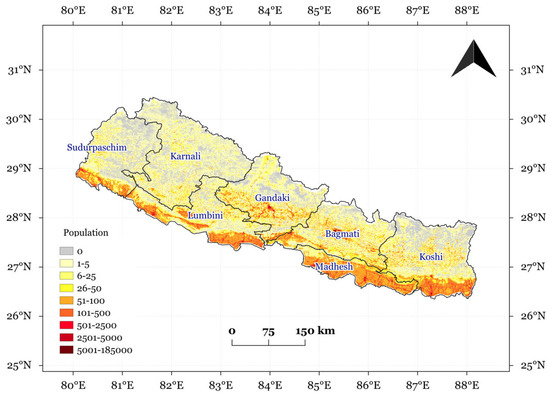
Figure 2.
Population map of Nepal derived from the LandScan Global Population Dataset for the year 2000.
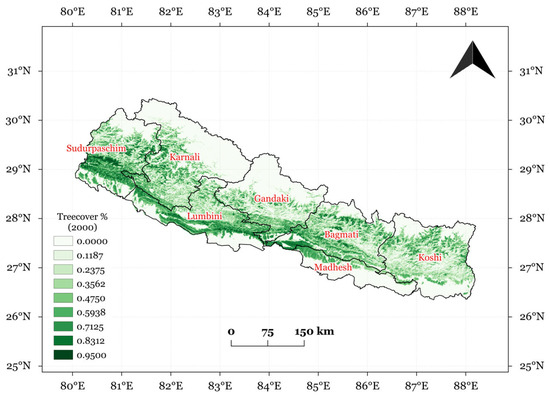
Figure 3.
Tree cover percentage in the base year 2000 for Nepal.
4. Materials and Methods
The time slices selected for this study were 2000, 2005, 2010, 2015, and 2020. These years were selected to map and monitor the tree cover and population dataset changes periodically, considering the dataset availability. First, the two datasets were imported into Google Earth Engine and clipped to the boundary of Nepal for the five selected years. Both the tree cover and population datasets are annual datasets. For consistency, the population dataset for the year 2000 was used as the reference or master grid. Tree cover rasters for all years were resampled and aligned to match the spatial resolution of the year 2000 population grid, which served as the master reference. Similarly, the population datasets for the other years were reprojected to the 2000 population grid. This ensured that all ten rasters (five for tree cover and five for population) were perfectly aligned pixel-by-pixel.
To extract the vegetation or tree cover percentage for a given year, the base year 2000 dataset is masked to exclude pixels where forest loss occurred prior to or during the target year, retaining only those where no loss occurred or where loss happened afterward. The following expression was used to compute vegetation tree cover for a target year:
where TreeCovert represents the tree cover raster for the target year ‘t’, TreeCover2000 is the baseline raster for tree cover in the year 2000, and LossYear is the loss year raster, with a value of 0 indicating no loss and values from 1 to 20 representing forest loss in the corresponding year from 2001 to 2020. Equation (1) is written as pseudocode to represent the raster calculation performed to derive tree cover for a target year. It expresses the logic used in Google Earth Engine, where the 2000 tree cover raster (TreeCover2000) is masked using the forest loss year raster (LossYear). This raster expression allowed the generation of annual tree cover layers based on cumulative forest loss.
For each corresponding year, only the intersecting pixels between the tree cover and population rasters were selected, ensuring the analysis focused on areas where data from both datasets were available. Table 1 presents the intersecting pixels for each of the five years. The selected data were then processed into 1 km × 1 km grid files using QGIS (v3.34), with each file containing latitude, longitude, tree cover percentage (hereafter treecover%), and population as attributes. These yearly grid files served as inputs for the regression analysis, with tree cover percentage as the dependent variable and population as the independent variable.

Table 1.
Number of valid pixels for tree cover, population, and their intersection for each selected year. The intersecting pixels represent areas where both datasets have overlapping, aligned values, used for further analysis.
4.1. Linear Regression
A linear regression (LR) analysis was conducted using Python’s (3.12.3) scikit module with ‘population’ as an independent variable and ‘treecover%’ as a dependent variable for each of the five years.
4.2. Geographically Weighted Regression
To capture spatial heterogeneity in the relationship between the tree cover and population across the entirety of Nepal, Geographically Weighted Regression (GWR) has been applied. It is an extension of linear regression (LR) that allows model coefficients to change across geographic space [45]. Unlike ordinary least squares (OLS), which estimates a single, global model, GWR generates localized models tailored to each spatial coordinate. The GWR model is formulated as
Here, (ui, vi) represents the spatial coordinates of each observation, and i and βk(ui, vi) denote the spatially varying coefficients estimated for each location. These coefficients are derived through a weighted least-squares method:
In this formulation, X is the design matrix of the predictor variable (population), Y is the response vector (tree cover percent), and Wi is a spatial weighting matrix that defines the influence of surrounding data points. The weights are computed using a kernel function, most commonly the Gaussian kernel:
where dij is the Euclidean distance between observation points i and j, and b is the bandwidth parameter that dictates the spatial scale of influence. The optimal bandwidth is selected by minimizing the Akaike Information Criterion (AIC), balancing model fit and complexity.
GWR analyses were conducted for 2000, 2005, 2010, 2015, and 2020, using an adaptive kernel bandwidth optimized through the corrected AIC (AICc). By accounting for spatial variation in relationships, GWR enables more nuanced interpretations of the link between tree cover and population, uncovering localized patterns that global models such as LR may miss. Two different outputs were presented: a derived spatial map and a summary table. The spatial map explores the local relationship between the variables, whereas the summary table gives a summary of the statistics. To validate the findings from the GWR analysis, supplementary visual inspections were conducted using high-resolution imagery available through Google Earth. This additional step allowed for a more detailed spatial verification of the GWR results. Specifically, areas that exhibited high R2 values in the GWR output, indicating strong model performance, were closely examined to assess actual changes in forest cover and land use/land cover. By visually comparing these regions with time-series imagery, the spatial patterns and accuracy of the GWR-predicted changes are assessed, thereby strengthening the overall validity of the analysis.
5. Results and Discussion
Forest loss by year, using a threshold of tree cover greater than 50%, derived from University of Maryland GLAD data (2001–2020), is shown in Figure 4. The plot indicates a clear decline in forest loss over time. Additionally, the relationship between Nepal’s total population and forest loss during the corresponding years showed a slight negative slope with a very weak correlation (R2 = 0.000290), suggesting that population growth had little to no direct impact on forest loss at the national level during this period (Figure 5). However, detailed spatial analysis revealed distinct localized patterns that suggest more complex patterns. While national trends indicate overall stability or improvement, several regions, particularly in the mid-hills and along urban fringes, exhibited concentrated forest degradation. These losses were often associated with infrastructure expansion, agricultural encroachment, and settlement growth and, in some cases, showed relatively strong correlations with population increases. These localized dynamics highlight the importance of sub-national analysis, as aggregated national statistics can obscure critical land cover change processes occurring at finer spatial scales.
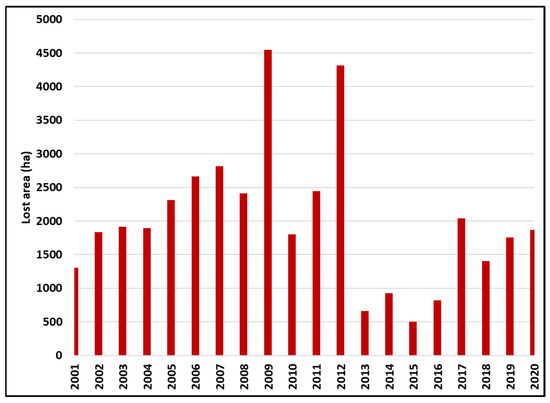
Figure 4.
Forest loss by year with threshold of tree cover greater than 50% for Nepal derived from GFC dataset. A clear decline in the lost area can be seen, suggesting effective forest protective measures in the country.
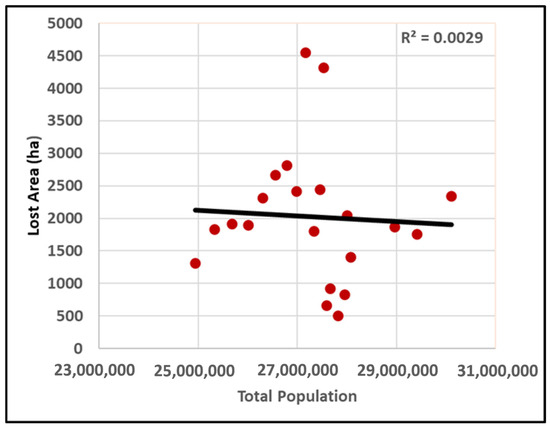
Figure 5.
Correlation between total population and forest loss area (2001–2020) in Nepal. The results suggest that population growth had little to no direct impact on forest loss at the national level during this period.
Ordinary least-squares linear regression explained almost none of the variance in tree cover loss, with R2 climbing only marginally from 0.01 in 2000 to 0.025 in 2005, 0.027 in 2010, 0.028 in 2015, and 0.039 in 2020, demonstrating that LR fails to capture any substantive relationship between population counts and tree cover loss over time.
In contrast, the GWR results demonstrate a consistent increase in R2 values over time, revealing a stronger spatial association between tree cover loss and population density. Specifically, the R2 value for GWR starts at 0.21 in the base year 2000, rises to 0.30 in 2005, and then to 0.38 in 2010. A notable increase occurs in 2015, with an R2 of 0.54, followed by a further rise to 0.59 in 2020. These findings underscore the spatial dependency inherent in the data and highlight the effectiveness of GWR in capturing localized relationships between population and deforestation.
Figure 6a–e illustrate the spatial results of the GWR model at the pixel level for different years. These maps reveal spatial variability in R2 values across the country. In 2000 and 2005, the highest local R2 values reached 0.64 and 0.77, respectively; in 2010, they peaked at 0.83; and in 2015 and 2020, they stayed at 0.82 and 0.81, respectively.
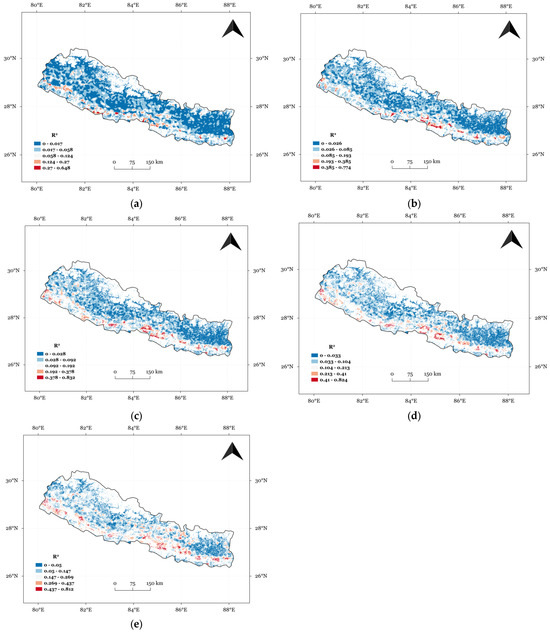
Figure 6.
(a–e) Geographically Weighted Regression results showing the relationship between tree cover loss and population count across different years: (a) 2000, (b) 2005, (c) 2010, (d) 2015, and (e) 2020. Notable spatial heterogeneity in R2 values is observed across the years. A decline in tree cover loss is also apparent over time.
To better understand the regions where population is most strongly correlated with tree cover loss, a detailed analysis was conducted for 2020. To validate the GWR findings, supplementary visual analysis was performed using high-resolution imagery from Google Earth to identify high-R2 areas, which were examined more closely through spatial zoom-ins (Figure 7a–d).
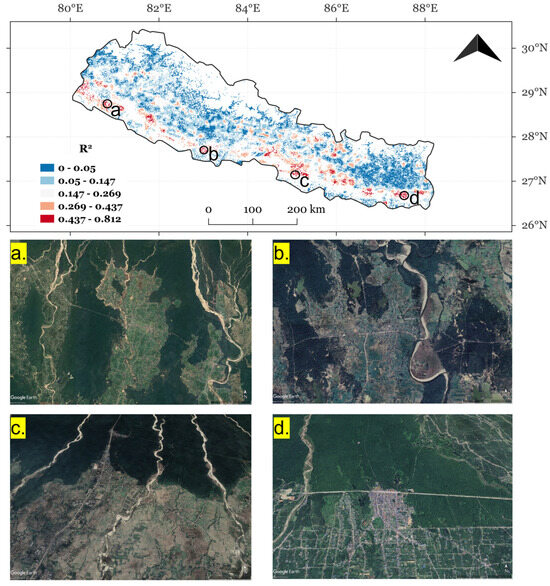
Figure 7.
(a–d) The top panel shows the Geographically Weighted Regression (GWR) output for the entire study area in 2020, showing spatial variation in local R2 values. Panels (a–d): Hotspot clusters with high local R2 values (>0.67), identified for further analysis. Very high-resolution images from Google Earth were used to confirm forest degradation in these locations.
The local R2 values for the identified hotspots range from 0.67 to 0.75. Specifically, Figure 7a–d illustrate four major hotspot locations characterized by notable land use/cover dynamics:
Hotspot (7a): Masuriya (80°49′5.72″ E, 28°44′58.32″ N): Located in the Gauriganga Municipality of Kailali District in Sudurpaschim Province, this area shows a local R2 of 0.67. The region is primarily characterized by agricultural expansion and settlement growth.
Hotspot (7b): Imiliya (82°59′13.07″ E, 27°39′36.66″ N): As a town in Bhudabhumi Municipality, Kapilbastu District of Lumbini Province, showing a local R2 of 0.69, this hotspot is experiencing transitions from agricultural lands to mixed-use development, with visible growth in built-up areas. The region’s proximity to transportation corridors has also contributed to land fragmentation and urbanization.
Hotspot (7c): Pipara Simara (84°59′28.64″ E, 27°9′3.50″ N): As a rapidly expanding urban area in Jitpur Simara Sub-Metropolitan City of Bara District, Madhesh Province, with a local R2 of 0.72, this hotspot is undergoing significant urbanization, with a marked increase in impervious surfaces including a decline in open/agricultural lands.
Hotspot (7d): Urlabari (87°33′38.74″ E, 26°39′38.96″ N): As a city located along the Mahendra Highway in Patahrishanishchare Municipality, Morang District, Koshi Province, with a local R2 of 0.72, this region has shown consistent growth in built-up areas. The land use transitions here are closely tied to urban migration and the expansion of transport and commercial infrastructure.
These hotspots represent regions where land use/cover dynamics are shifting rapidly. The relatively high local R2 values confirm the spatial relevance of the GWR model in capturing these patterns.
In addition to the previously discussed hotspots, the table below presents the top 10 locations with the highest local R2 values, sorted in descending order. Interestingly, all of these high-correlation points are located within Madhesh Province, as shown in Table 2.

Table 2.
Top 10 locations in Madhesh Province with the highest local R2 values between tree loss and population in 2020.
Further, a closer examination of spatial patterns reveals that the identified GWR hotspots are predominantly concentrated along Nepal’s major transportation corridor—the Mahendra Highway (East–West Highway). This highway stretches from Bhim Dutta in the far west to Mechinagar in the far east, connecting key urban centers and driving development across the Terai region. Many of the high-R2 areas in the 2020 GWR analysis are situated near this corridor, suggesting that proximity to major roads is a critical factor in accelerating deforestation. These regions are likely experiencing rapid urbanization, agricultural expansion, and infrastructure development, all facilitated by increased accessibility. The spatial extent of these hotspots and their alignment with the East–West Highway are illustrated in Figure 8. A shapefile containing the coordinates and boundaries of these identified hotspots is available upon request for further research, planning, or policy development.
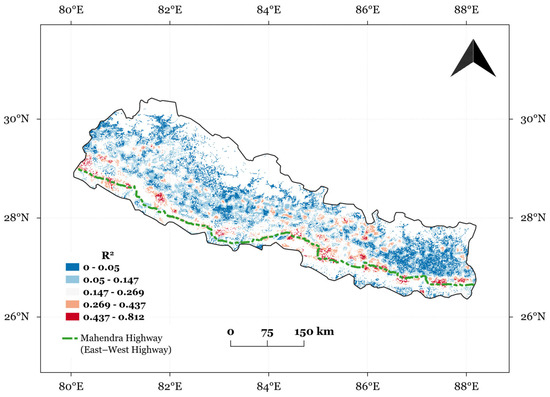
Figure 8.
Map showing the spatial distribution of Geographically Weighted Regression hotspot clusters for the year 2020 in relation to the East–West Mahendra Highway (shown in green). Most of the identified hotspots are located in and around this major transportation corridor, highlighting the influence of highway-driven urbanization and land use change on tree cover loss.
The observed relationship between population distribution and tree cover loss in Nepal highlights a pressing environmental concern: as population increases, particularly in rapidly developing or accessible areas, there is a corresponding rise in tree cover loss and vegetation degradation. This trend is especially evident in regions with expanding urban footprints, agricultural frontiers, and infrastructure projects. The results reveal that the tree cover loss is not uniform across the country, but is instead strongly influenced by localized human activities and demographic pressures. To effectively capture and analyze this spatially complex relationship, traditional global modeling approaches such as Linear Regression (LR) are insufficient, as they assume a uniform relationship across space and fail to account for local variations. In contrast, Geographically Weighted Regression (GWR) demonstrated that it provides a more nuanced, spatially adaptive framework by allowing regression parameters to vary over space, thereby identifying region-specific patterns and hotspots of tree cover loss associated with population pressure, as captured in this study. The increasing R2 values from 2000 to 2020 observed in the GWR analysis also indicate that the influence of population on deforestation has become more spatially structured over time. Furthermore, integrating very high-resolution (VHR) spatial data significantly enhances the precision and reliability of such analyses. By enabling pixel-level assessments, VHR data allows for the detection of fine-scale patterns and localized environmental impacts typically obscured in coarser datasets. This combination of GWR modeling and VHR imagery offers a powerful toolset for identifying deforestation hotspots, validating spatial trends with visual evidence, and supporting targeted environmental management. Notably, many of the areas with high local R2 values are situated along the Mahendra Highway corridor, a key axis of development in the Terai region. This spatial alignment suggests that accessibility and infrastructure development are major drivers of forest loss, and that spatially informed planning is essential to balance growth with ecological sustainability.
6. Conclusions
- This study demonstrates that the relationship between population growth and tree cover loss in Nepal is spatially variable and has become increasingly structured over time.
- The correlation between total population and forest loss (2000–2020) at the national level in Nepal suggests little to no direct impact of population growth on forest loss. However, sub-national analysis revealed localized forest degradation, especially in the mid-hills and urban fringes, highlighting the importance of thorough spatial and regional assessments to uncover forest and land cover changes masked by national trends.
- Traditional linear regression models fail to capture these complexities. In contrast, Geographically Weighted Regression (GWR), supported by very high-resolution (VHR) spatial data, provides a more accurate and insightful understanding of localized environmental dynamics.
- Increasing R2 values between the tree cover loss and population over the past two decades in some regions of Nepal highlight a growing spatial association between population distribution and tree cover loss, particularly in areas experiencing rapid development and improved accessibility.
- High-R2 hotspots identified using GWR along the Mahendra Highway corridor reveal the critical role of infrastructure in shaping land use change.
- These findings not only validate the effectiveness of GWR and VHR data in capturing fine-scale human–environment interactions but also highlight the urgent need for spatially informed decision-making.
- As Nepal continues to develop, integrating spatial analytics into land management and policy frameworks will be essential to mitigate environmental degradation and promote sustainable development across the country.
Funding
Funding support from the NASA Land Cover/Land Use Change Program (grant code: SCEX22023D) is gratefully acknowledged.
Institutional Review Board Statement
Not applicable.
Informed Consent Statement
Not applicable.
Data Availability Statement
The datasets used in this study are publicly available: GFC Dataset: Available via Google Earth Engine at https://developers.google.com/earth-engine/datasets/catalog/UMD_hansen_global_forest_change_2024_v1_12 (accessed on 21 March 2025). The original study describing this dataset is cited in [43]. LandScan Global Population: https://developers.google.com/earth-engine/datasets/catalog/projects_sat-io_open-datasets_ORNL_LANDSCAN_GLOBAL (accessed on 21 March 2025).
Acknowledgments
The author thanks Krishna P. Vadrevu, NASA MSFC, for his support and guidance throughout the research and manuscript development process.
Conflicts of Interest
The author declares no conflict of interest.
Abbreviations
The following abbreviations are used in this manuscript:
| LR | Linear Regression |
| GWR | Geographically Weighted Regression |
| R2 | Coefficient of Determination |
| VHR | Very High Resolution |
| ORNL | Oak Ridge National Laboratory |
| UMD | University of Maryland |
| USGS | United States Geographical Survey |
| NASA | National Aeronautics and Space Administration |
| AIC | Akaike Information Criterion |
| AICc | Corrected Akaike Information Criterion |
| OLS | Ordinary Least Squares |
| ESA | European Space Agency |
| GFC | Global Forest Change |
| LULC | Land Use Land Cover |
| QGIS | Quantum Geographic Information System |
| GEE | Google Earth Engine |
References
- Nowak, D.J. Urban biodiversity and climate change. In Urban Biodiversity and Design; Blackwell Publishing Ltd.: Oxford, UK, 2010; pp. 101–117. [Google Scholar]
- Aram, F.; García, E.H.; Solgi, E.; Mansournia, S. Urban green space cooling effect in cities. Heliyon 2019, 5, e01339. [Google Scholar] [CrossRef]
- De Carvalho, R.M.; Szlafsztein, C.F. Urban vegetation loss and ecosystem services: The influence on climate regulation and noise and air pollution. Environ. Pollut. 2019, 245, 844–852. [Google Scholar] [CrossRef] [PubMed]
- Ferrini, F.; Fini, A.; Mori, J.; Gori, A. Role of vegetation as a mitigating factor in the urban context. Sustainability 2020, 12, 4247. [Google Scholar] [CrossRef]
- De la Barrera, F.; Rubio, P.; Banzhaf, E. The value of vegetation cover for ecosystem services in the suburban context. Urban For. Urban Green. 2016, 16, 110–122. [Google Scholar] [CrossRef]
- DeFries, R.; Asner, G.; Houghton, R. (Eds.) Ecosystems and Land Use Change; Geophysical Monograph Series; AGU: Washington, DC, USA, 2004; Volume 153. [Google Scholar]
- Bloom, D.E.; Canning, D.; Malaney, P.N. Population dynamics and economic growth in Asia. Popul. Dev. Rev. 2000, 26, 257–290. [Google Scholar]
- Rahman, M.M.; Husnain, M.I.U.; Azimi, M.N. An environmental perspective of energy consumption, overpopulation, and human capital barriers in South Asia. Sci. Rep. 2024, 14, 4420. [Google Scholar] [CrossRef]
- Teo, H.C.; Lamba, A.; Ng, S.J.W.; Nguyen, A.T.; Dwiputra, A.; Lim, A.J.Y.; Nguyen, M.N.; Tor-ngern, P.; Zeng, Y.; Dewi, S.; et al. Reduction of deforestation by agroforestry in high carbon stock forests of Southeast Asia. Nat. Sustain. 2025, 8, 358–362. [Google Scholar] [CrossRef]
- Koh, M.; Teo, R.; Tan, E. Deforestation and Forest Degradation: Drivers and Impacts on Biodiversity in Southeast Asia. J. Selvic. Asean 2024, 1, 198–207. [Google Scholar]
- Nandini, S. Colonial Exploitation and Beyond: Revisiting Indian Environmental History and Historiography. South India J. Soc. Sci. 2024, 22, 297–303. [Google Scholar] [CrossRef]
- Sundar, N. Unpacking the ‘joint’ in joint forest management. Dev. Change 2000, 31, 255–279. [Google Scholar] [CrossRef]
- Kumar, S. Status of India’s Forests. In Forest Policies, Laws, and Governance in India; Springer Nature: Singapore, 2024; pp. 207–232. [Google Scholar]
- Khurram, S.; Shalizi, M.N.; Bashari, M.; Akamani, K.; Groninger, J.W. Barriers and opportunities regarding community-based forest management in Afghanistan. Environ. Conserv. 2024, 51, 6–16. [Google Scholar] [CrossRef]
- Gouhari, S.; Forrest, A.; Roberts, M. Cost-effectiveness analysis of forest ecosystem services in mountain areas in Afghanistan. Land Use Policy 2021, 108, 105670. [Google Scholar] [CrossRef]
- Islam, S.D.U.; Bhuiyan, M.A.H. Sundarbans mangrove forest of Bangladesh. Environ. Sustain. 2018, 1, 113–131. [Google Scholar] [CrossRef]
- Rasul, G. Political ecology of the degradation of forest commons in the Chittagong Hill Tracts of Bangladesh. Environ. Conserv. 2007, 34, 153–163. [Google Scholar] [CrossRef]
- Ahmad, A.; Liu, Q.-J.; Nizami, S.M.; Mannan, A.; Saeed, S. Carbon emission from deforestation, forest degradation and wood harvest in Pakistan. Land Use Policy 2018, 78, 781–790. [Google Scholar] [CrossRef]
- Sabir, M.; Ali, Y.; Khan, I.; Salman, A. Plant species selection for afforestation: A case study of the Billion Tree Tsunami Project of Pakistan. J. Sustain. For. 2022, 41, 537–549. [Google Scholar] [CrossRef]
- Ranwala, S.M. Threats and Conservation of Biodiversity in Sri Lanka. In Biodiversity Hotspot of the Western Ghats and Sri Lanka; Apple Academic Press: Palm Bay, FL, USA, 2024; pp. 599–614. [Google Scholar]
- Baral, S.; Paudel, S.; Basnyat, B.; Rai, R.K. The Economics of Forest Restoration: A cost-effectiveness analysis of the leasehold forestry programme in Nepal. Trees For. People 2025, 19, 100785. [Google Scholar] [CrossRef]
- Pandey, H.P.; Maraseni, T.N.; Apan, A.; Pokhrel, S.; Zhang, H. Lessons from a participatory forest restoration program on socio-ecological and environmental aspects in Nepal. Trees For. People 2025, 20, 100854. [Google Scholar] [CrossRef]
- Marquardt, K.; Khatri, D.; Pain, A. REDD+, forest transition, agrarian change and ecosystem services in the hills of Nepal. Hum. Ecol. 2016, 44, 229–244. [Google Scholar] [CrossRef]
- The World Bank. World Development Indicators—Nepal. 2024. Available online: https://data.worldbank.org/country/nepal (accessed on 16 June 2025).
- International Monetary Fund (IMF). Nepal: Country Data and Projections. 2024. Available online: https://www.imf.org/en/Countries/NPL (accessed on 16 June 2025).
- World Bank KNOMAD. Migration and Development Brief 41: Remittances Remain Resilient. 2024. Available online: https://www.knomad.org/publication/migration-and-development-brief-41 (accessed on 15 June 2025).
- Department of Forest Research and Survey (DFRS). State of Nepal’s Forests. Ministry of Forests and Soil Conservation, Government of Nepal. December 2015. Available online: https://frtc.gov.np/downloadfiles/StateofNepalsForestsDFRS_1457599484-1729667336.pdf (accessed on 15 June 2025).
- Ministry of Forests and Environment (MoFE). National Biodiversity Strategy and Action Plan 2014–2020: Final Assessment Report. Government of Nepal. 2019. Available online: https://www.cbd.int/doc/world/np/np-nbsap-v2-en.pdf (accessed on 16 June 2025).
- Federation of Community Forestry Users Nepal (FECOFUN). Annual Progress Report 2022/23. 2023. Available online: https://fecofun.org.np/ (accessed on 16 June 2025).
- Gautam, A.P.; Webb, E.L.; Eiumnoh, A. GIS assessment of land use/land cover changes associated with community forestry implementation in the Middle Hills of Nepal. Mt. Res. Dev. 2002, 22, 63–69. [Google Scholar] [CrossRef]
- Food and Agriculture Organization of the United Nations (FAO). Global Forest Resources Assessment 2020: Nepal Country Report. 2020. Available online: https://www.fao.org/forest-resources-assessment (accessed on 15 June 2025).
- Central Bureau of Statistics (CBS). National Population and Housing Census 2021: National Report. National Statistics Office, Government of Nepal: Kathmandu, Nepal, May 2023. Available online: https://censusnepal.cbs.gov.np/results/files/result-folder/National%20Report_English.pdf (accessed on 15 June 2025).
- Chapagain, P.S.; Aase, T.H. Changing forest coverage in Nepal Himalayas. Geogr. J. Nepal 2020, 13, 1–28. [Google Scholar] [CrossRef]
- Bhattarai, K.; Adhikari, A.P.; Gautam, S.P. State of urbanization in Nepal: The official definition and reality. Environ. Chall. 2023, 13, 100776. [Google Scholar] [CrossRef]
- Rijal, S.; Sinutok, S.; Techato, K.; Gentle, P.; Khanal, U.; Gyawali, S. Community-managed sal-based forest in climate change adaptation. Forests 2022, 13, 262. [Google Scholar] [CrossRef]
- Government of Nepal. The Forests Act, 2019 (2076). Law Commission of Nepal. 2019. Available online: https://faolex.fao.org/docs/pdf/nep202856.pdf (accessed on 16 June 2025).
- Government of Nepal, Ministry of Forests and Environment. National Forest Policy, 2015. 2015. Available online: https://redd.gov.np/upload/e66443e81e8cc9c4fa5c099a1fb1bb87/files/ESMF__with_IPPF_and_RPF__NE_FFPP_8Mar2020.pdf (accessed on 16 June 2025).
- The World Bank. Nepal and World Bank Sign Innovative Financing Agreement on Forests and Climate Change for Building Back Greener. Press Release, 26 February 2021. 2021. Available online: https://www.worldbank.org/en/news/press-release/2021/02/26/nepal-and-world-bank-sign-innovative-financing-agreement-on-forests-and-climate-change-for-building-back-greener (accessed on 16 June 2025).
- Thapa, M. Internal Migration in Nepal. Unity J. 2025, 6, 79–92. [Google Scholar] [CrossRef]
- World Bank Group. Nepal Country Profile. Available online: https://databank.worldbank.org/reports.aspx?source=2&country=NPL (accessed on 27 March 2025).
- Flora of Nepal. Provinces and Districts. Available online: https://floraofnepal.org.np/distribution-physiographic-regions-provinces-and-districts (accessed on 27 March 2025).
- Google Earth Engine. LandScan Global. Available online: https://developers.google.com/earth-engine/datasets/catalog/projects_sat-io_open-datasets_ORNL_LANDSCAN_GLOBAL (accessed on 21 March 2025).
- Hansen, M.C.; Potapov, P.V.; Moore, R.; Hancher, M.; Turubanova, S.A.; Tyukavina, A.; Thau, D.; Stehman, S.V.; Goetz, S.J.; Loveland, T.R.; et al. High-resolution global maps of 21st-century forest cover change. Science 2013, 342, 850–853. [Google Scholar] [CrossRef] [PubMed]
- Bhaduri, B.; Bright, E.; Coleman, P.; Dobson, J. LandScan: Locating people is what matters. Geoinformatics 2002, 5, 34–37. [Google Scholar]
- Fotheringham, A.S.; Brunsdon, C.; Charlton, M. Geographically weighted regression. In The Sage Handbook of Spatial Analysis; SAGE Publications Ltd.: New York, NY, USA, 2009; pp. 243–254. [Google Scholar]
Disclaimer/Publisher’s Note: The statements, opinions and data contained in all publications are solely those of the individual author(s) and contributor(s) and not of MDPI and/or the editor(s). MDPI and/or the editor(s) disclaim responsibility for any injury to people or property resulting from any ideas, methods, instructions or products referred to in the content. |
© 2025 by the author. Licensee MDPI, Basel, Switzerland. This article is an open access article distributed under the terms and conditions of the Creative Commons Attribution (CC BY) license (https://creativecommons.org/licenses/by/4.0/).